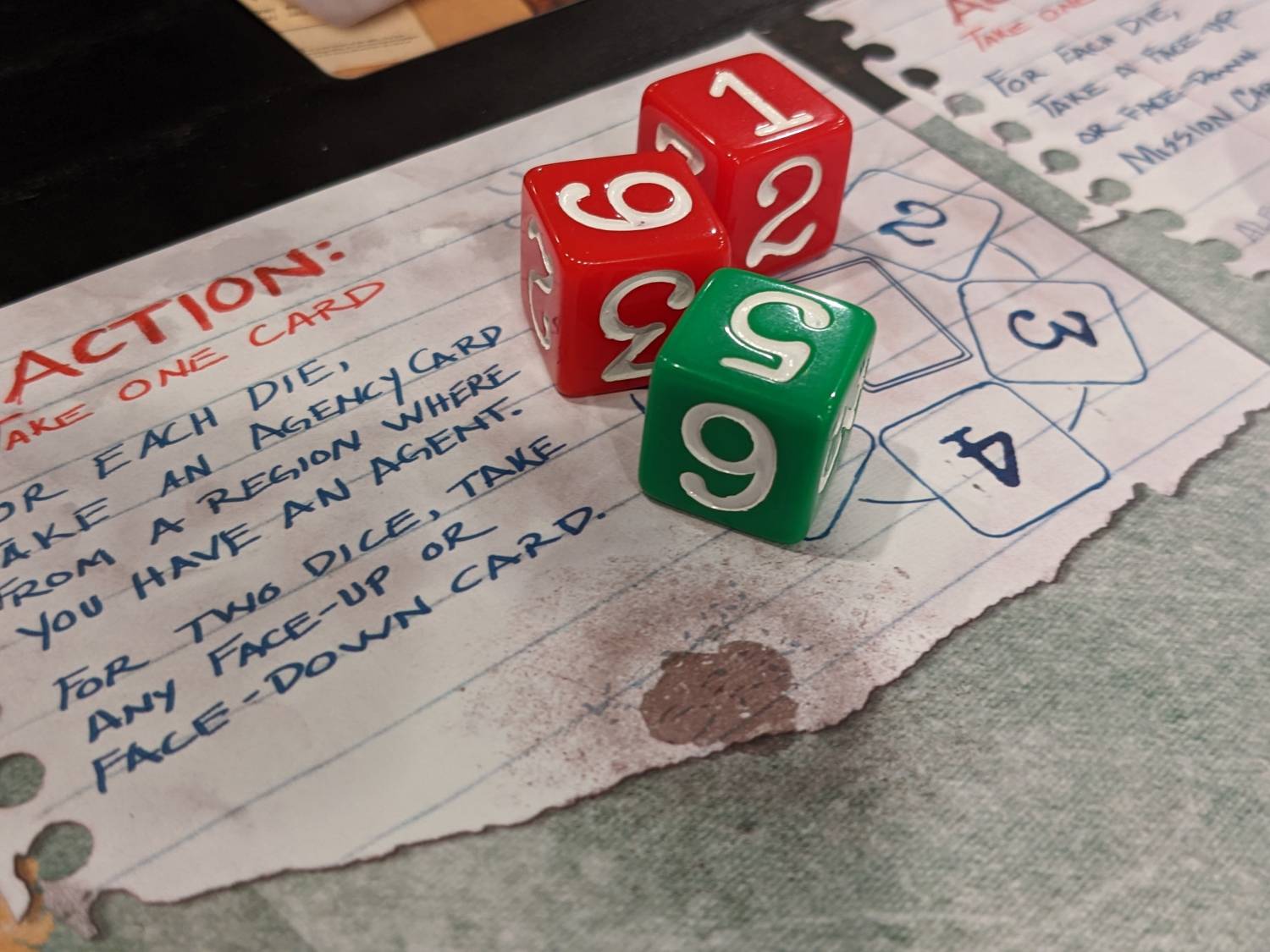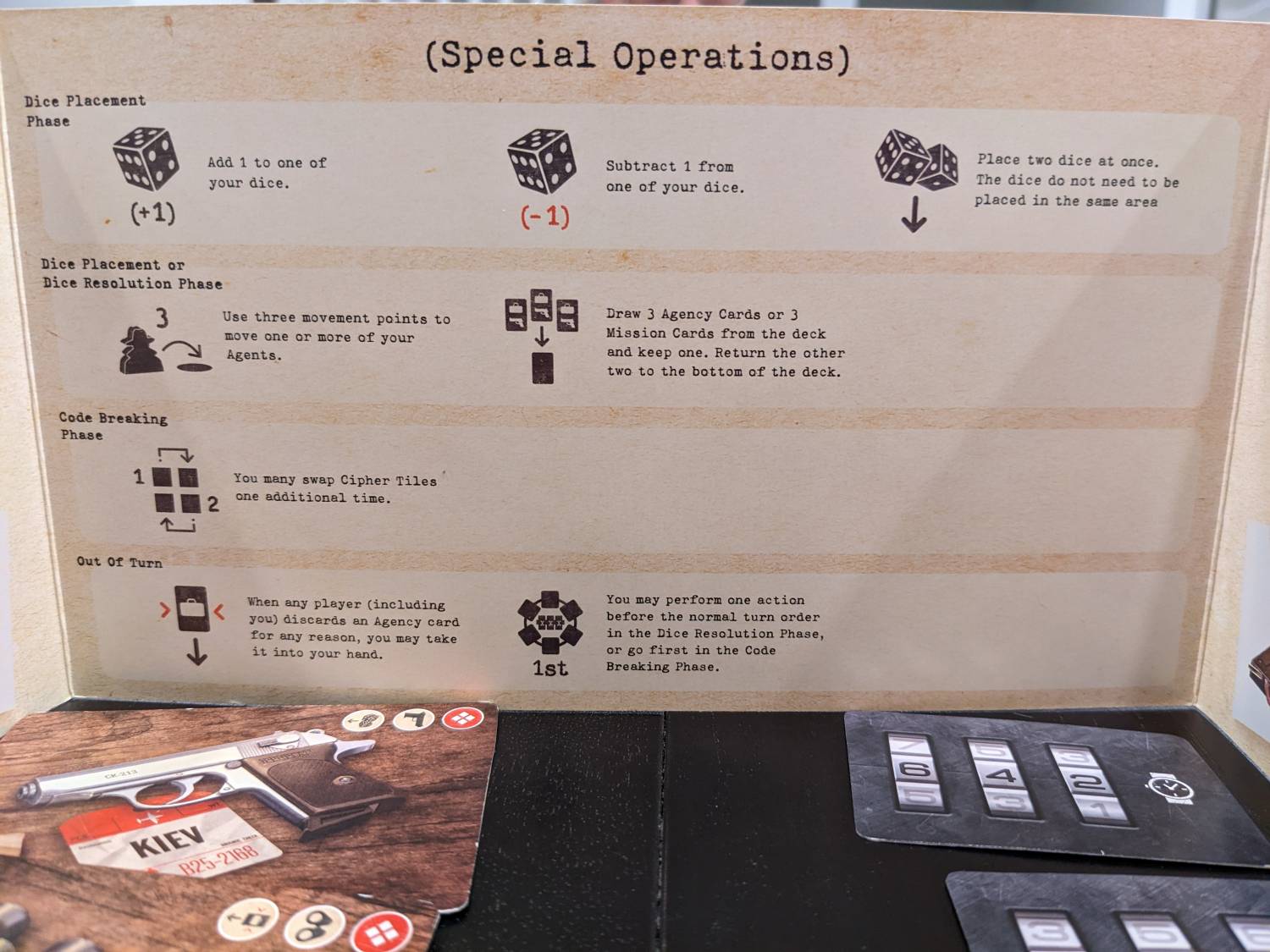I remember it like it was yesterday.
I sat down in a booth at my first Gen Con with designer Kane Klenko. Kane was there to demo Covert (2016, Renegade Studios) and while walking by the table, I saw lots of things that excite me about games: dice, a spy theme, dice placement locations, multi-use cards. A board that feels like Europe from 60 years ago. Player screens to hide your components. Variable player powers.
Then, this, from Klenko: “Believe it or not, I like playing Covert most with only two players.”
This intrigued me; at the time, I really wasn’t playing many two-player games with my wife, but I saw an opening with Covert. Maybe this would be the kind of mid-weight experience we could play often, especially after the kids went to bed?
I was right. And then some.

Roll Dice, Block Your Friends
Covert gives you the feeling that you are completing covert operations all over Europe for a rogue spy agency (maybe good, maybe nefarious; what if I’m working for SPECTRE?). The idea here is that players are out collecting items like a lockpick or fake passports to complete “Missions”, but the secret agent veneer wears off quickly.
In the game, you are running around the map with three Agent meeples, trying to complete Missions with Agency cards that represent the items you need to score points at the end of play.
Whenever a player completes their sixth Mission, that marks the final round; after play is completed, you’ll have the chance to use those Agency cards to complete at most one more Mission from your hand. Missions range in value from 3-15 points, so making the most of each Mission becomes important. Some of the Missions also grant you a symbol which eliminates one requirement on future Missions.
That’s the game—but the best part of Covert comes when you need to roll and place your five dice each round. (A miss on the part of the designers: these dice are just known as dice. Not Spy Dice, or Covert Dice, or Mission Dice, or Danger Dice. Just…dice.)
Dice placement is fantastic here thanks to the rules. In turn order, each player places one of their dice on one of the four Action Circles at the top of the board. From there, they can select the main actions taken in the next phase of play: Movement, Agency Cards, Mission Cards, and Complete Mission.

These are the actions players will take after dice placement in the Dice Resolution phase, and all of them are exactly what you would think: taking cards from face-up markets, moving Agents around the map, or handing in the cards needed to complete Missions. (Some Missions also require an Agent to be standing in a specific city or one of the six regions on the map.)
But placing those dice is where the game is magic. If the Action Circle is empty, you can place a die in any of the six spots numbered 1-6. If the circle has a die inside already, you can only place a die adjacent to another die.
That’s when you’ll start looking around the table (or at your wife, if you are me) to see what the other player(s) have rolled. And, if you can take an action and close your opponent out of that same action by placing a die in a space that completely hoses them, that feels good.
If your dice can’t be placed on an Action Circle, you could put it on a space that allows you to take tokens from a draw bag featuring special game-breaking actions. So, you’ll still get something out of each round even if you get forced off of the Action Circles.
You can also use a die to affect the Break Codes phase (after Dice Placement and before Dice Resolution), where you can swap Cipher Tiles to score two-point cards dealt during setup that double as resources that can be used to complete later Missions.

Those Multi-Use Cards!
The Agency cards in Covert give you three options:
- Discard the card to use its Special Ability, which can be used during the Dice Placement phase or during the action rounds;
- Discard the card to fly an Agent directly to the city listed on the card;
- Discard the card to satisfy one of the conditions of a Mission
But wait! Your hand limit is only seven cards. How will a person be able to horde enough cards to do what they want every turn? Ahh, you can’t my friend, which is why I love some of these more difficult choices.
For the most part, players will get Agency cards by using the Action Circle tied to gathering more cards. But you can also get Agency cards by moving your Agents around the board to grab Intel Cubes; these Cubes are dropped whenever a rival Agent moves between cities. When two Cubes of the same color are gathered, the active player gets to take an Agency card matching the region where their Agent collected the second cube.

What Doesn’t Work
Covert is not a perfect game. It’s a dice game, so by starting each round with a dice roll, there’s a chance that your dice are not going to grant much flexibility when trying to get spots on the Action Circles. Also, player powers are distributed to begin each game, and a couple of them are blatantly better than the others, notably the power that allows for a player to swap Cipher Tiles more often than normal, or a power that allows for a player to get two free Agent moves every round. (These powers can be selected at the beginning of each game at random or by choice; definitely do it by choice with face-up cards!)
Randomness with the Mission deck is certainly an issue; some of the Missions are just worth a lot more points than others, and when you see a slate of low-point Missions in the small three-card market, you will sweat a little. That’s because you could top-deck a Mission and still end up with a terrible, six-point Mission when other players are drawing better ones. Worse, there’s no real rhyme or reason with these Missions, despite the requirements; some are worth 10+ points and grant an ongoing power, while some of the ones that are worth less don’t grant any extras.
Most games of Covert end up with very close scores, so every edge can make the difference.

But For Some Reason…
Covert still rises to the top of games that pique my wife’s interest on game night. Covert is not an all-time classic—it’s hovering in the top 1,000 strategy games on BGG.
But Covert just works for us, and whenever we show others the game, they love it and ask to play it again. My favorite Covert experience happened right after I bought the game back in 2016: my high school gaming friends and I did a weekend of games and Covert made it to the table for four straight plays. We never do that, so it was clearly a hit as a four-player game with my guys that first weekend.
Covert clearly didn’t sell well enough to warrant expansion content, because six years later, all that is available is the base game. More player powers and different Missions might expand the experience, or adding another Action Circle might offer more ways to get dice on the board. But that’s OK; what’s here is fine, and it’s all that is needed for me. I’ve played Covert more than 30 times and it still feels fresh, especially as an hour-long, two-player game with fun choices and a breezy race to the end-game triggers.












Add Comment